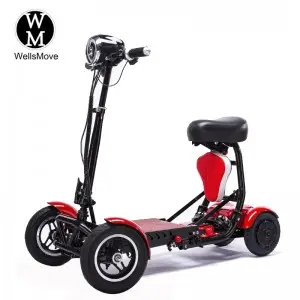The Mobility Advantages of Electric Scooters Over Traditional Wheelchairs
Electric Scooters: Redefining Freedom of Movement, a Mobility Revolution Beyond Traditional Wheelchairs
For people with limited mobility, “mobility” is more than just a matter of getting around; it’s a pursuit of independent living, social participation, and even greater control over their lives. Traditional manual wheelchairs have long been the mainstream assistive device, meeting basic mobility needs but facing significant limitations in terms of range, terrain adaptability, and ease of use. With technological advancements, electric scooters, with their more powerful powertrains, more flexible usage scenarios, and more user-friendly designs, are gradually breaking the boundaries of traditional wheelchair use, offering users unprecedented freedom of movement. This article will deeply analyze the mobility advantages of electric scooters over traditional wheelchairs from six core perspectives, allowing you to rediscover the possibilities of “barrier-free mobility.”
I. Power Mode Innovation: From “Physical Strength Reliance” to “Intelligent Drive,” Freeing Hands and Energy
The core drawback of traditional manual wheelchairs is their complete reliance on the user’s upper body strength—propelling the wheels, steering, and even navigating minor obstacles requires significant physical effort. This not only places high demands on the user’s upper limb function (such as joint flexibility and muscle strength), but prolonged use can also easily lead to shoulder and neck strain, wrist pain, and other problems, making it particularly unsuitable for elderly users or those with limited upper limb strength.
Electric scooters, on the other hand, completely break free from the constraints of “physical drive” and instead achieve autonomous mobility through a motor-driven system. Users can easily control forward, reverse, turn, and speed using a joystick, touchscreen, or smart control panel (some models support voice control), without relying on upper limb strength. For example, our flagship model, the “E-Freedom X1,” features a 400W brushless motor that enables stepless speed adjustment from 0 to 6 km/h. Even users with limited fine motor skills can precisely control the direction using the customizable joystick. This “intelligent drive” mode not only reduces physical strain but also allows users to focus on “where to go” rather than “how to get there,” truly realizing the first step to “mobility freedom.”
II. Improved Range: Say Goodbye to “Short-Distance Anxiety” and Expand Your Travel Radius
The range of traditional manual wheelchairs relies entirely on the user’s physical strength, typically lasting no more than 1-2 hours on a single trip, and travel distances are strictly limited to 1-3 kilometers (e.g., short trips around the neighborhood or to the supermarket). Beyond this range, users risk exhaustion and being unable to return, significantly reducing their living space.
Electric scooters, on the other hand, achieve breakthroughs in long-range driving thanks to their large-capacity lithium-ion batteries. Mainstream models offer a single charge range of 15-30 kilometers and continuous use time of 4-6 hours. This means users can easily complete scenarios like a 5-kilometer walk from home to the park, a 10-kilometer shopping trip to the local mall, or even a short outing with family (20-kilometer round-trip), completely eliminating short-distance anxiety. For example, our “E-Comfort Y2″ model, equipped with a large-capacity 12Ah lithium-ion battery, boasts a range of up to 25 kilometers at a constant speed, allowing for all-day travel, even with frequent stops and starts (e.g., avoiding pedestrians or waiting at traffic lights). Furthermore, electric scooters are extremely convenient to charge using a household 220V outlet, fully charging in 8-10 hours, making them perfectly suited for everyday home use.
Third, Breakthrough Terrain Adaptability: From “Flat Limits” to “All-Scenes Accessibility,” Fulfilling Complex Road Conditions
Traditional manual wheelchairs have extremely demanding requirements for road conditions—they can only navigate flat, smooth, hard surfaces (such as indoor floors and tiled paths in shopping malls). They can become immobilized or even face the risk of tipping over when encountering slight slopes (e.g., the gentle slope at a residential building entrance), uneven surfaces (e.g., cobblestones or grass), or small obstacles (e.g., 1-2 cm steps). This is also the core reason why many users, even those with manual wheelchairs, find it difficult to leave their homes and enjoy the outdoors.
Electric scooters utilize specialized tire design and power tuning to achieve robust adaptability to complex road conditions:
Upgraded tires: 8-10-inch tubeless tires with deeper treads and enhanced grip ensure stable operation even on wet asphalt, soft grass, or uneven stone pavement.
Gradability: Mainstream electric scooters have a maximum climbing angle of 8°-12°, easily navigating common slopes like those at residential entrances and underground garage entrances without assistance.
Obstacle-climbing capabilities: Some high-end models (such as our “E-Tough Z3″) are equipped with small-diameter training wheels that can easily negotiate 3-5cm steps and curbs, allowing users to navigate freely in parks, scenic areas, and other outdoor settings, freeing them from the constraints of “flat surfaces.” This all-scenario mobility capability elevates electric scooters from mere “indoor tools” to true “travel companions” that can accompany users outdoors and experience nature.
Fourth, Convenient Operation and Docking: From “Tedious Collaboration” to “One-Touch Control,” Improving Independent Travel Efficiency
Traditional manual wheelchairs often require assistance when operating and docking. For example, pushing requires adjusting body posture to maintain balance, steering requires coordinated effort from both hands, and docking requires assistance from others to secure the wheels (to prevent slipping). Furthermore, repeated readjustment is required in narrow passages (such as elevators and hallways), making this a cumbersome and time-consuming operation.
Electric scooters feature user-friendly design, minimizing operational complexity and enabling users to control them with just one click:
Flexible Steering: Featuring rear-wheel drive and front-wheel steering, they offer a turning radius of just 1.2-1.5 meters, making U-turns and directional adjustments easy, even in narrow elevators or hallways, without the need for repeated maneuvers.
One-Touch Parking: Equipped with an electromagnetic braking system, the scooter automatically parks when the lever is released, eliminating the need to manually lock the wheels. This effectively prevents the scooter from sliding, making it particularly suitable for parking on slopes or uneven surfaces.
Intelligent Assistance: Select models feature features such as a low-speed warning sound (to prevent pedestrians from being startled by silent driving), a real-time battery life indicator (to indicate remaining battery life), and a USB charging port (to conveniently charge mobile phones), further enhancing user convenience.
V. Upgraded Comfort and Safety: From “Basic Support” to “All-Round Protection,” Improving the Travel Experience
Traditional manual wheelchairs are designed with “basic mobility” in mind, but they suffer from significant shortcomings in comfort and safety. For example, seats are often made of hard plastic or thin sponge, which can easily lead to pressure sores on the buttocks after prolonged use. They lack shock absorption, resulting in a strong jolting sensation on uneven surfaces. Safety features rely solely on simple armrests, making it easy for users to fall forward in emergencies (such as sudden braking).
Electric scooters, on the other hand, prioritize user experience and have undergone comprehensive upgrades in comfort and safety.
Comfort Design:
The seat is made of high-resilience memory foam and breathable mesh fabric, ensuring comfort and preventing pressure sores after prolonged sitting.
The seat height and backrest angle are adjustable (some models offer 360-degree rotation), accommodating users of different heights and body shapes.
Equipped with front and rear shock absorption systems, they effectively filter vibrations and reduce impact on bumpy roads. Safety Protection:
In addition to electromagnetic braking, it also features manual brake assist, providing dual-route safety.
The body is constructed of a high-strength aluminum alloy frame, capable of bearing a load of 120-150kg and offering strong impact resistance.
Select models are equipped with LED headlights (for nighttime driving) and taillights (to alert pedestrians behind), further enhancing all-weather safety.
This comprehensive protection allows users to enjoy the freedom of mobility while also feeling protected and secure—whether on long rides, at night, or in the rain, they remain comfortable and safe.
Sixth: Social and Psychological Value: From “Passive Dependence” to “Active Participation,” Rebuilding Confidence in Life
In addition to the practical mobility advantages described above, electric scooters also provide users with deeper “social and psychological value.” The physical reliance and limited use of traditional manual wheelchairs often put users in a state of passive waiting—needing to be accompanied by family members before leaving the house, and requiring assistance from others for simple shopping and social activities. This can lead to long-term psychological problems such as self-denial and social withdrawal.
The independent mobility afforded by electric scooters essentially allows users to regain control of their lives: they can decide when to go, where to go, and who to meet, without having to rely on others’ schedules. This sense of initiative not only helps users reintegrate into society (such as participating in community events and gatherings with friends), but also rebuilds their confidence. When you can independently drive an electric scooter, stroll through the park with your family, or have coffee with friends, you are no longer someone who needs care, but someone who can take control of their own lives. We once received feedback from a user: “When I used a manual wheelchair, every time I wanted to go to the park to play chess with my friends, I had to wait for my son to take me there on weekends. After switching to an electric scooter, I can drive to the park by myself every morning, chat with everyone, and play chess. I feel like I’m ‘alive’ again.” This “rediscovered freedom” is the most precious value of electric scooters over traditional wheelchairs.
Conclusion: Electric scooters are more than just a means of transportation; they are a lifestyle choice.
Traditional manual wheelchairs address the basic need for mobility, while electric scooters achieve the higher goal of free, safe, and comfortable movement. From manual propulsion to intelligent propulsion, from short distances of 1 km to a range of 30 km, and from smooth roads to all-encompassing mobility, every advantage of electric scooters is breaking down the boundaries of mobility for people with limited mobility, giving them the courage and ability to travel freely. If you or your family are struggling with the limitations of a traditional wheelchair, consider an electric scooter. It’s more than just a tool; it’s a choice for active living. Choosing one means choosing a broader social circle, greater independence, and the opportunity to rediscover every moment worth exploring.
Post time: Sep-29-2025



